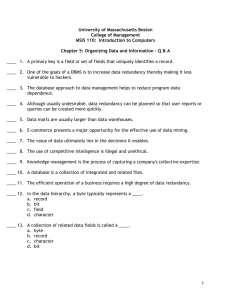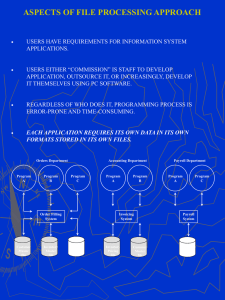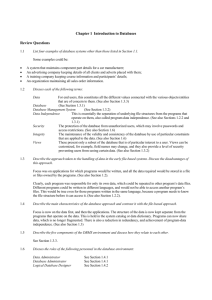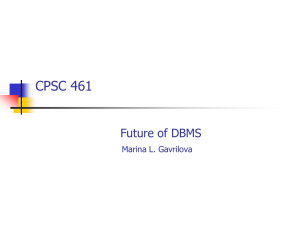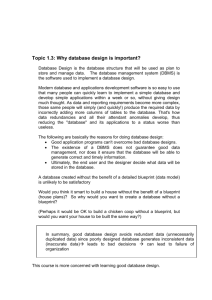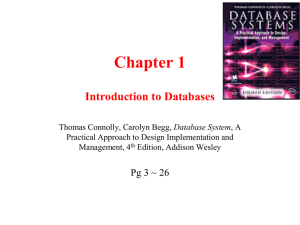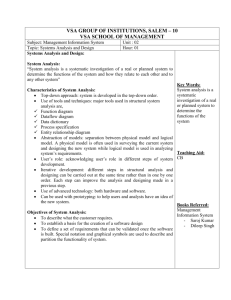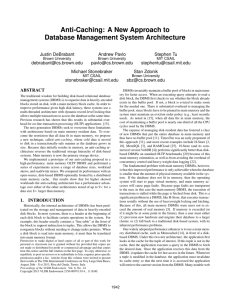SYLLABUS
advertisement
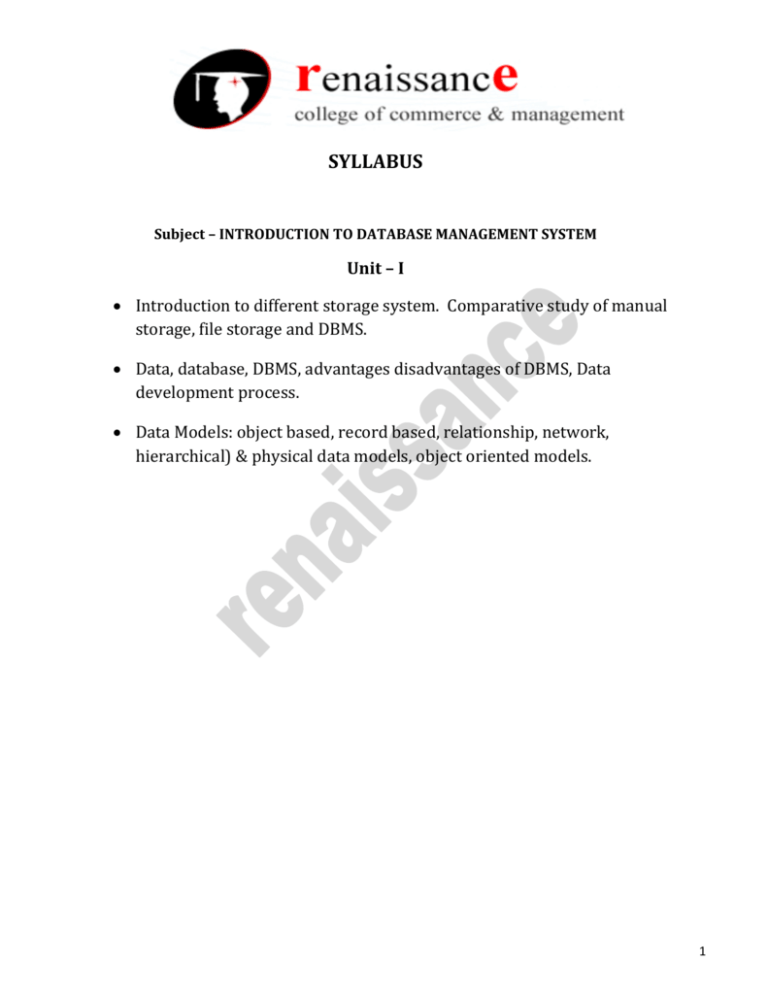
SYLLABUS Subject – INTRODUCTION TO DATABASE MANAGEMENT SYSTEM Unit – I Introduction to different storage system. Comparative study of manual storage, file storage and DBMS. Data, database, DBMS, advantages disadvantages of DBMS, Data development process. Data Models: object based, record based, relationship, network, hierarchical) & physical data models, object oriented models. 1 DataBase Management System B.com IV Sem. (Computer) Introduction to different storage system:There are a number of characteristics to distinguish the database approach from the traditional approaches of programming with files. In traditional file processing, each user defines and implements the files needed for a specific application as part of programming the application. In database approach, a single repository of data is maintained that is defined once and then is accessed by various users. The main characteristics of the database approach versus the file processing approach are as follows: Self-describing nature of a database system Insulation between programs and data, and data abstraction Multiple views of the data Sharing of data and multiuser transaction processing Advantages of database approach versus traditional file approach are as follows: Controlled redundancy and reduced inconsistency Data independence Concurrent access with multiple user views Data integrity Data security Backup and recovery Easy accessing of data Data isolation No atomicity problem Data:The raw facts that can be stored or recorded and that have a clear meaning is called data. Database:A collection of data designed to be used by different people is called a database. It is collection of interrelated data stored together with controlled redundancy to serve one or more applications in an optimal fashion. A database system is basically a computer based record keeping system. The collection of data, usually referred to as the database, contains information about one particular enterprise. Purpose of Database – The database system should be repository of the data needed for an organization data processing. The data should be accurate, private & protected from damage. It should be organized so that diverse application with different data requirements can employ the data when needed. Advantages of DBMS – 1) Database reduced the data redundancy to a large extent. 2) Database can control inconsistency to a large extent. 3) Database facilitate sharing of data. 4) Database enforces standards. 2 5) Database can ensure data security & privacy. 6) Integrity can be maintained through database. 7) Conflicting requirement can be balance through database. Characteristics of data – The data stored in database should have this characteristics – 1) Shared 5) Consistency 2) Persistence 6) Non-redundancy 3) Validity / integrity 7) Data independence. 4) Security Database Development Process Database Development process can be classically thought of as a systematic process which can be divided into following steps – 1) Interpreting the need of an organization. 2) Identifying the business rules 3) Analyzing the business situations and data 4) Designing the database and defining the functional dependencies. Database Users – A primary goal of database system is to provide an environment for retrieving information from and storing new information into the database. There are four different types of database users, differentiated by the way that they expect to interact with the system – 1) Application programmer 3) Specialized users 2) Sophisticated users 4) Naïve Users Database Administrator – The person who has central control over the system is called database Administrator. The function of DBA include – 1) Schema definition 4) Granting of Authorization for data access. 2) Storage structure and access method 5) Integrity – Constraints specifications definition 6) Routine maintenance 3) Schema and physical organization, modification Database Management System – A Database Management System is a collection of program that enable users to store, create, modify & extract information from a database. The DBMS is hence a general propose software system that facilitate the process of defining, constructing & manipulating database for various applications. The major activities, operations & services provided by DBMS are as follows – 1) Transaction Management 5) Language Interface 2) Concurrency Control 6) Storage Management 3) Recovery Management 7) Data Catalog Management. 4) Security Management Applications of DBMS – There are different applications of Database Management System as its competitive era the DBMS is used in following areas. 1) Banking 2) Airlines 3 3) 4) 5) 6) Organization Universities, Credit Card Transactions Tele Communications 7) Finance 8) Sales 9) Human Resources 10) Manufacturing etc. Data Models – Data models are different models that can be used to design a database. Design a database include describing data, data relationship, data semantics and consistency constraints. Various data models are as follows – Object based data Model – Object based logical model are used in describing data at a logical & view levels. They are characterized that they provide fairly flexible structure in capabilities & allow data constraints to be specified explicitly. This model emphasis on the fact that everything is a object having a setoff attributes. There are different data models that utilizes this characteristics – 1) The entity relationship model 3) The semantic data model 2) The object oriented model 4) The functional data model 1) The entity relationship model – Entity relationship model moves around three things – a) Entity, b) Relationship & c) Attribute. ER-Model is based on perception that everything that have physical properties that is entity, every two entities can be distinguish from other. Relationship exists between these entities. 2) The object oriented model – Object Oriented Model as name indicates takes everything as object is based on collection of object. Object contains values stored in instance variable within the object. An 4 object also contained bodies of code that operate on the object. These bodies of code are called method. 3) The semantic data model 4) The functional data model Limitation of DBMS – 1) High initial investment in Hardware Software & Training 2) Generality that a DBMS provide for defining and processing the data. 3) Overhead for providing security, concurrency control & Integrity function. Record Based Data Model – Record based logical model are used in describing data at the logical and view level. In contrast to object based data model they are used both to specify the overall logical structure of the database and to provide a higher level description of implementation. Record based model are so named because the database is structured in fixed format records of several type. The three most widely used record based data models are – 1) Relational Model 2) Network Model 3) Hierarchical Model 1) Relational Model – This is most popular among the various record based data model. This model uses a collection of table to represent both data and the relationship among those data. 2) Network Model – Data in network model are represented by collection of records and relationship among the data are represented by links (Pointer). A Pointer is a physical address which identifies where the next record can be found on the disk. 5 3) Hierarchical Model – It is very similar to network model. In this data model records are organized as collection of tree rather than arbitrary graphs. Physical Data Model – This model is used to describe data at the lowest level that is to describe to behavior of data at the disk level i.e. the way of data and the data relationship are maintain by storing them on the disk. This deciding the way the DBMS is going to used secondary storage devices for storing and accessing database. The widely used data models are – 1) Unifying model 2) Frame memory model 6

